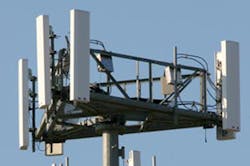Growth of applications in millimeter-wave frequency bands, such as E-band frequencies from 71 to 76 GHz, has raised the demand for compact antennas capable of handling them. To fill the needs for antennas at these higher frequencies, Jia-Chi Samuel Chieh from Spawar Systems Center San Diego; Bing Pham and Anh-Vu Pham from the School of Electrical and Computer Engineering of the University of California at Davis; and George Kannell and Alex Pidwerbetsky from LGS Innovations from Bell Laboratory (Florham Park, N.J.) developed dual-polarized, aperture-coupled stacked patch antennas with substrate embedded air cavities for use at W-band frequencies from 75 to 110 GHz.
The antennas were realized in a multilayer organic hybrid substrate using both Kapton and liquid crystal polymer (LCP). In particular, a single-element antenna achieved a 23-GHz bandwidth with 90-deg. beamwidth and better than 17.8-dB isolation. The researchers faced developing antennas at high frequencies with small wavelengths. For example, at 75 GHz, the wavelength in free space is only 4 mm. Since the antenna feed is a critical part of the antenna design, the researchers explored two antenna feed structures: a general symmetric feedline and a microstrip balun.
An antenna was designed with interleaved Kapton adhesive and LCP layers, forming a substrate with embedded air cavities, with the Kapton substrate exhibiting a dielectric constant of about 3.2. Simulations were performed on the antenna design to study the effects of varying driven and parasitic patch characteristics, as well as the cavity height. Prototype low- and high-isolation antennas were constructed, and a T-junction power combiner was used to allow one-port measurements to be taken.
Testing was performed with a model N5251A vector network analyzer (VNA) from Agilent Technologies (now Keysight Technologies). An antenna probe station was created with ECCOSORB HR-10 material from Emerson & Cuming to provide electromagnetic-interference (EMI) shielding. The simulated and measured results for the low-isolation design matched closely, with simulated isolation of better than 6-dB across the full W-band frequency range.
For higher isolation between horizontal and vertical polarizations, a differential feed was used for one of the polarizations. Better than 17 dB isolation was achieved, with a measured bandwidth of about 28 GHz from about 71 to 99 GHz. The researchers did a great deal of additional work on these antennas, achieving good performance through about 105 GHz. See “Millimeter-Wave Dual-Polarized High-Isolation Antennas and Arrays on Organic Substrates,” IEEE Transactions on Antennas and Propagation, December 2013, p. 5,948.
About the Author
Jack Browne
Technical Contributor
Jack Browne, Technical Contributor, has worked in technical publishing for over 30 years. He managed the content and production of three technical journals while at the American Institute of Physics, including Medical Physics and the Journal of Vacuum Science & Technology. He has been a Publisher and Editor for Penton Media, started the firm’s Wireless Symposium & Exhibition trade show in 1993, and currently serves as Technical Contributor for that company's Microwaves & RF magazine. Browne, who holds a BS in Mathematics from City College of New York and BA degrees in English and Philosophy from Fordham University, is a member of the IEEE.
